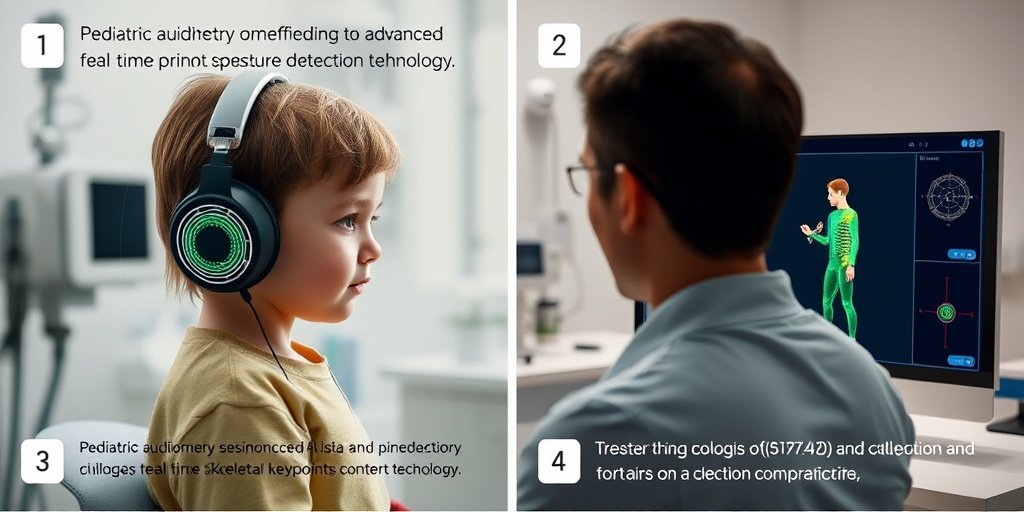⚡ Quick Summary
This study investigates the use of deep learning technology in pediatric behavioral audiometry, demonstrating its feasibility and accuracy in assessing children’s hearing levels. The developed model, named DoT, utilizes a dedicated dataset to automate posture recognition during hearing tests, significantly enhancing the testing process.
🔍 Key Details
- 📊 Dataset: A dedicated pediatric posture detection dataset with numerous video clips from behavioral hearing tests.
- 🧩 Features used: Video data capturing typical hearing test actions of children.
- ⚙️ Technology: Intelligent diagnostic model of pediatric hearing based on optimized transformer (DoT) and patient skeletal keypoints estimation model (POTR).
- 🏆 Performance: Sensitivity and specificity metrics for AI behavior audiometry and artificial behavior audiometry across different age groups.
🔑 Key Takeaways
- 🤖 Deep learning enhances the accuracy of pediatric behavioral audiometry.
- 📈 Sensitivity for AI behavior audiometry was 0.929 for children aged 2.5-4 years, while artificial behavior audiometry had a sensitivity of 0.900.
- 🔍 Specificity for artificial behavior audiometry was higher (0.824) compared to AI behavior audiometry.
- 👶 For children aged 4-6 years, artificial behavior audiometry outperformed AI behavior audiometry in sensitivity (0.943) and specificity (0.947).
- 🌟 The study provides a foundation for early screening and treatment of hearing disorders in children.
- 📅 Trial Registration: Chinese Clinical Trial Registry, ChiCTR2100050416.

📚 Background
Assessing hearing in young children can be challenging due to their limited ability to communicate effectively. Traditional methods often rely on subjective interpretations, which can lead to inconsistent results. The integration of deep learning technologies into pediatric audiometry represents a significant advancement, promising more objective and reliable assessments.
🗒️ Study
Conducted with 120 children aged between 2.5 to 6 years, this study aimed to develop a robust model for recognizing children’s postures during conditioned play audiometry. The researchers collected extensive video data to train the DoT model, which was designed to automate the recognition of specific actions related to hearing tests.
📈 Results
The findings revealed that the DoT model achieved impressive results in posture recognition. For children aged 2.5-4 years, the sensitivity of AI behavior audiometry was 0.929, while for those aged 4-6 years, it reached 0.943. The specificity and Area Under Curve (AUC) metrics also indicated strong performance, particularly for artificial behavior audiometry in the older age group.
🌍 Impact and Implications
The implications of this study are profound. By automating the assessment of children’s hearing through advanced deep learning technologies, healthcare providers can offer more accurate and timely diagnoses. This innovation not only streamlines the testing process but also lays the groundwork for early intervention in hearing disorders, ultimately improving outcomes for children.
🔮 Conclusion
This research highlights the transformative potential of deep learning in pediatric audiometry. The development of the DoT model signifies a step forward in providing objective assessments of children’s hearing abilities. As we continue to explore the integration of AI in healthcare, the future looks promising for enhancing diagnostic accuracy and patient care.
💬 Your comments
What are your thoughts on the use of deep learning in pediatric audiometry? We would love to hear your insights! 💬 Join the conversation in the comments below or connect with us on social media:
Behavior recognition technology based on deep learning used in pediatric behavioral audiometry.
Abstract
This study aims to explore the feasibility and accuracy of deep learning-based pediatric behavioral audiometry. The research provides a dedicated pediatric posture detection dataset, which contains a large number of video clips from children’s behavioral hearing tests, encompassing various typical hearing test actions. A detection platform based on this dataset is also constructed, named intelligent diagnostic model of pediatric hearing based on optimized transformer (DoT); further, an estimation model of patient skeletal keypoints based on optimized transformer (POTR) was proposed to estimate human skeleton points. Based on this, the DoT approach was handled to perform posture recognition on videos of children undergoing behavioral hearing tests, thus enabling an automated hearing testing process. Through this platform, children’s movements can be monitored and analyzed in real-time, allowing for the assessment of their hearing levels. Moreover, the study establishes decision rules based on specific actions, combining professional knowledge and experience in audiology to evaluate children’s hearing levels based on their movement status. Firstly, we gathered image and video data related to posture in the process of conditioned play audiometry to test the hearing of 120 children aged 2.5 to 6 years old. Next, we built and optimized a deep learning model suitable for pediatric posture recognition. Finally, in the deployment and application phase, we deployed the trained pediatric posture recognition model into real-world application environments. We found that for children aged 2.5 - 4 years, the sensitivity of artificial behavior audiometry (0.900) was not as high as that of AI behavior audiometry (0.929), but the specificity of artificial behavior audiometry (0.824) and Area Under Curve (AUC) (0.901) was higher than that of AI behavior audiometry. For children aged 4-6 years, the sensitivity (0.943), specificity (0.947), and AUC (0.924) of artificial behavioral audiometry were higher than those of AI behavioral audiometry. The application of these rules facilitates objective assessment and diagnosis of children’s hearing, providing essential foundations for early screening and treatment of children with hearing disorders.Trial Registration: Chinese Clinical Trial Registry: Registration number ChiCTR2100050416.
Author: [‘Xie W’, ‘Li C’, ‘Peng H’, ‘Liu Y’, ‘Zhang Z’, ‘Cheng X’, ‘Liu J’]
Journal: Sci Rep
Citation: Xie W, et al. Behavior recognition technology based on deep learning used in pediatric behavioral audiometry. Behavior recognition technology based on deep learning used in pediatric behavioral audiometry. 2025; 15:15648. doi: 10.1038/s41598-025-97519-w